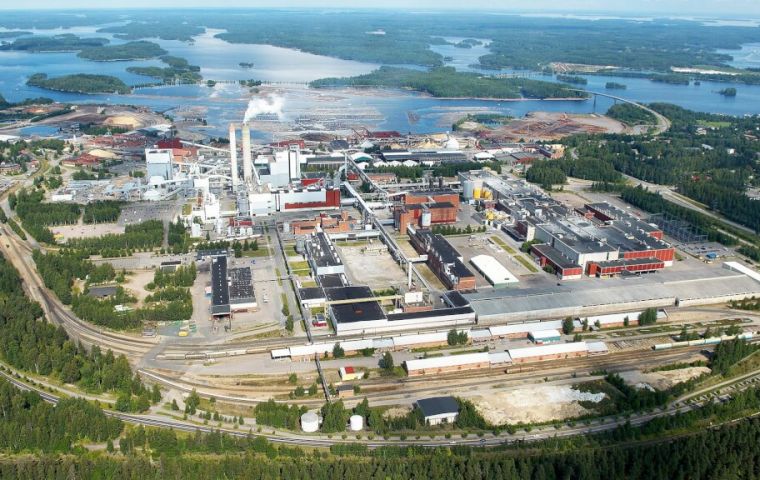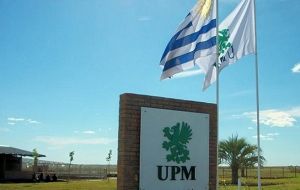MercoPress. South Atlantic News Agency
Finland's UPM will construct a second 2.1 million ton pulp mill in Uruguay
 The mill investment is expected to total US$ 2,7 billion and is expected to begin production in 2022
The mill investment is expected to total US$ 2,7 billion and is expected to begin production in 2022  The mill will be located in one of Uruguay’s many free trade zones and pay a fixed annual tax of US$ 7 million per annum
The mill will be located in one of Uruguay’s many free trade zones and pay a fixed annual tax of US$ 7 million per annumFinland's UPM on Tuesday made the investment decision to construct a 2,1 million ton eucalyptus pulp mill near Paso de los Toros in central Uruguay.
The highly competitive mill investment of US$ 2,7 billion will grow UPM’s current pulp capacity by more than 50%, resulting in a step change in the scale of UPM’s pulp business as well as in UPM’s future earnings. Additionally, UPM will invest US$ 350 million in port operations in Montevideo and local facilities in Paso de los Toros. The mill is scheduled to start up in the second half of 2022.
With a combination of competitive wood supply, scale, best available techniques and efficient logistics the mill is expected to reach a highly competitive cash cost level, approximately US$ 280 per delivered ton of pulp. This figure includes the variable and fixed costs of plantation operations, wood sourcing, mill operations and logistics delivered to the main markets. This would position the mill as one of the most competitive mills in the world and enable attractive returns for the investment in various market scenarios. Furthermore, the safety and sustainability performance of the value chain from plantations to customer delivery is expected to be on an industry leading level.
The prerequisites for the investment have been carefully prepared in cooperation with the state of Uruguay. For UPM, it has been important to ensure sustainable, competitive operations long-term and to minimize risks both in the project phase and during continuous operations. For Uruguay, the project and the infrastructure development offer significant opportunities for economic and social development.
“During the past decade UPM has developed additional plantation areas in Uruguay and created a market driven pulp business with wide customer base in growing end uses. At the same time, we have consistently improved our financial performance and achieved a truly industry leading balance sheet. We are now in an excellent position to take this transformative step and capture the opportunities of attractive, growing markets in a sustainable and highly competitive way,” said Jussi Pesonen, President and CEO of UPM.
Attractive long-term market outlook
The business fundamentals for the investment are positive given the healthy long-term demand outlook of pulp, especially in Asia. The robust market growth is based on global consumer megatrends that drive the demand for tissue, hygiene, packaging and specialty papers. The annual trend growth of global market pulp demand is estimated to be about 3%.
In the coming three years, only limited additional capacity is expected to enter the markets. In the long term, creating a competitive and sustainable wood supply forms an entry barrier which limits the rate at which new capacity can enter the market.
Competitive wood supply
The eucalyptus availability for the mill is secured through UPM’s own and leased plantations as well as through wood sourcing agreements with private partners. Over 30 years of experience in plantation operations secures well managed and productive plantations without making compromises on sustainability. Today, the plantations that UPM owns and leases in Uruguay cover 382,000 hectares. They will supply the current UPM Fray Bentos mill and the new mill near Paso de los Toros.
State of the art mill design
The pulp mill has been designed as an efficient single-line operation and represents the state-of-the-art in the pulp industry. The machines, materials, level of automation and standards enable a high operating rate and maintainability as well as high energy output, ensuring excellent safety, high environmental performance as well as low operating costs during the long life-cycle of the mill.
The mill investment is expected to total US$ 2,7 billion which represents highly efficient investment level when comparing with corresponding pulp mill investments over the past few years.
The mill is designed to fully meet the strict Uruguayan environmental regulations as well as international standards and recommendations for modern mills, including the use of latest and best available proven technology (BAT). Mill’s environmental performance will be verified with comprehensive and transparent monitoring.
The mill’s initial annual production capacity is 2,1 million tons, and the environmental permits enable further capacity potential.
When in operation, the mill generates more than 110 MW surplus of renewable electricity providing a stable source of revenue and strengthening Uruguay´s energy balance.
Efficient logistics set-up
Efficient logistics chain is fundamental to the mill’s competitiveness and supply security in global markets. This will be secured by the agreed road improvements, extensive railway modernization and port terminal construction. These infrastructure investments also support economic activity in other sectors in Uruguay. Initial works on the central railway have been started and financing of the railway construction consortium is proceeding but is yet to be finalized.
UPM has decided the construction of a deep-sea pulp terminal in Montevideo port with an investment of approximately US$ 280 million. Direct rail access from the mill to a modern deep sea port terminal creates an efficient supply chain to world markets. Montevideo deep sea port also enables synergies in ocean logistics with UPM’s existing Uruguay operations as all pulp can be delivered in full vessels directly to main markets.
UPM plans to enter into port terminal concession and rail logistic services agreements that will be recognized as lease assets and liabilities under IFRS 16 Leases. The total amount of such lease assets and liabilities is expected to be US$ 200 million.
Community investments
In addition to the mill and port investments, UPM will invest in a new residential area in Paso de los Toros and provide temporary housing for the project personnel. The company will also fund the improvement of municipal waste water treatment plant and restoration of the municipal landfill in Paso de los Toros. The local investments outside the mill fence total US$ 70 million.
Significant impact on Uruguayan economy
Based on independent socioeconomic impact studies, the mill is estimated to increase Uruguay’s gross national product by about 2% and the annual value of Uruguay’s exports by approximately 12% after completion.
“For decades Uruguay has shown a consistent long-term vision in developing the prerequisites for industrial operations and building the foundation for foreign investment. I humbly recognize the determination with which the decision makers have made way for the country’s economic development. Today’s decision will bring many new opportunities for small and medium sized companies and educated workforce in the central part of Uruguay benefitting thousands of Uruguayans for decades to come,” says Pesonen.
In the most intensive construction phase, there will be more than 6,000 persons working on the site. When completed, approximately 10,000 permanent jobs are estimated to be created in the Uruguayan economy whereof 4,000 would be directly employed by UPM and its subcontractors. About 600 companies are estimated to be working in the value chain.
The mill will be located in one of Uruguay’s many free trade zones and pay a fixed annual tax of US$ 7 million per annum. The mill’s value chain is expected to contribute US$ 170 million in annual taxes and social security payments and contribute annually US$ 200 million in wages and salaries.
Project schedule and capital outflow
The necessary permits have been granted and the material agreements with the Government of Uruguay have been concluded to the satisfaction of both parties.
The Public-Private-Partnership agreement between the government and the construction company for the construction of the central railway was signed in May 2019 and the financing of the construction company is being finalized.
Among other project preparations, the site works for the mill and dredging of the port are commencing immediately. The tendering for the main equipment and manning of the project is ongoing. Commitments on major capital outlays will be made in line with the railway financing and execution.
The mill is expected to start up in the second half of 2022. The main part of the total capital expenditure of US$ 3 billion will take place in 2020–2022. UPM will have 91% ownership in the project and a local long-time partner which has been involved also in UPM Fray Bentos is owning 9%. UPM’s investment will be mainly financed by operating cash flow complemented by regular group financing activities.
Following today’s decision UPM increases the estimate for total capital expenditure in 2019 to EUR 450 million from the previous estimate of EUR 350 million.




Top Comments
Disclaimer & comment rulesCommenting for this story is now closed.
If you have a Facebook account, become a fan and comment on our Facebook Page!